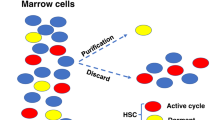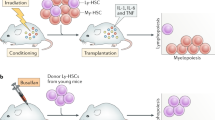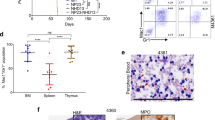Abstract
THE pluripotent haemopoietic stem cell has been the object of many investigations in murine and human systems, but the origin of lymphoid cells from the human pluripotent stem cell has not been definitively established. In mice, investigations using the spleen colony technique1 have demonstrated the existence of a pluripotent stem cell which can give rise to mixed colonies of erythrocytes and granulocytes2. Further studies with radiation-induced chromosome markers in murine systems have provided evidence for the origin of lymphoid cells from this stem cell3–5. The use of X-linked glucose-6-phosphate dehydrogenase (G-6-PD) isoenzymes as cell markers has provided another approach, applicable to the evaluation of human proliferative disorders6,7. Those females with electrophoretically distinguishable G-6-PD isoenzymes who have clonal haematological disorders provide a source for such studies. Thus, Fialkow et al.8 have demonstrated the origin of erythrocytes, granulocytes, megakaryocytes, and macrophages from a myelogenous stem cell in studies of patients with chronic myelocytic leukaemia. We have used G-6-PD markers in a study of peripheral blood cells from a patient with acquired idiopathic sideroblastic anaemia, and shown the origin in humans of B and T lymphocytes from a common stem cell whose other progeny include erythrocytes, granulocytes, megakaryocytes, and macrophages. In addition, acquired idiopathic sideroblastic anaemia is shown, in this instance, to be a clonal disorder.
This is a preview of subscription content, access via your institution
Access options
Subscribe to this journal
Receive 51 print issues and online access
$199.00 per year
only $3.90 per issue
Buy this article
- Purchase on Springer Link
- Instant access to full article PDF
Prices may be subject to local taxes which are calculated during checkout
Similar content being viewed by others
References
Till, J. E. & McCulloch, E. A. Radiat. Res. 14, 213–222 (1961).
Wu, A. M., Till, J. E., Siminovitch, L. & McCulloch, E. A. J. cell. Physiol. 69, 177–184 (1967).
Wu, A. M., Till, J. E., Siminovitch, L. & McCulloch, E. A. J. exp. Med. 127, 455–464 (1968).
Trentin, J. et al. J. Immun. 98, 1326–1337 (1967).
Abramson, S., Miller, R. G. & Phillips, R. A. J. exp. Med. 145, 1567–1579 (1977).
Linder, D. & Gartler, S. M. Science 150, 67–69 (1965).
Fialkow, P. J. New. Engl. J. Med. 291, 26–35 (1974).
Fialkow, P. J., Jacobson, R. J. & Papayannopoulou, T. Am. J. Med. 63, 125–130 (1977).
Sparkes, R. S., Baluda, M. C. & Townsend, E. E. J. Lab. clin. Med. 73, 531–534 (1969).
Beutler, E., West, C. & Blume, K.-G. J. Lab. clin. Med. 88, 329–333 (1976).
Bøyum, A. Scand. J. clin. Lab. Invest. 21, Suppl. 97, 1–109 (1968).
Moretta, L., Ferrarini, M., Durante, M. L. & Mingari, M. C. Eur. J. Immun. 5, 565–569 (1975).
Adamson, J. W., Fialkow, P. J., Murphy, S., Prchal, J. F. & Steinmann, L. New. Engl. J. Med. 295, 913–916 (1976).
Author information
Authors and Affiliations
Rights and permissions
About this article
Cite this article
PRCHAL, J., THROCKMORTON, D., CARROLL, A. et al. A common progenitor for human myeloid and lymphoid cells. Nature 274, 590–591 (1978). https://doi.org/10.1038/274590a0
Received:
Accepted:
Issue Date:
DOI: https://doi.org/10.1038/274590a0
This article is cited by
-
Changes in peripheral blood lymphocytes in polycythemia vera and essential thrombocythemia patients treated with pegylated-interferon alpha and correlation with JAK2 V617F allelic burden
Experimental Hematology & Oncology (2015)
-
FAB classification of myelodysplastic syndromes: merits and controversies
Annals of Hematology (1995)
Comments
By submitting a comment you agree to abide by our Terms and Community Guidelines. If you find something abusive or that does not comply with our terms or guidelines please flag it as inappropriate.



